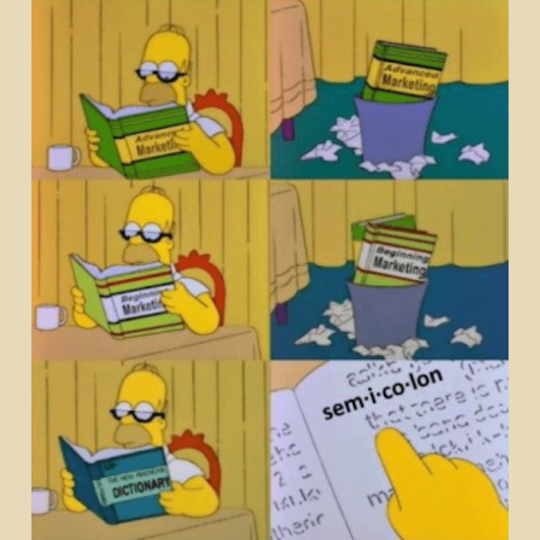Pretty simple post this time and we’re gonna look at three things to improve your writing, including the difference between colons and semicolons, and the correct construction of bullet points. Let’s dive on in!
Contents:
Quotation marks
Quotation marks mean just that – marks used for quotations. Let’s look at a couple of examples of how quotation marks should be used:
- My mother always said, “Be careful of strange men.”
- My friend’s favourite Shakespeare quote is “Better a witty fool than a foolish wit.”
Quotation marks are not used for emphasis. Very often, you’ll see random sentences or phrases enclosed in quotation marks. For example, a sign at a gym I used to go to: “Instruction is required from a professional trainer prior to using this equipment”. Why does that need quotation marks? Does your message lose its meaning without them? Absolutely not! Therefore, it’s totally unnecessary to use them.
You know when you use those little air quotes with your fingers to signify sarcasm? Like ‘Oh yeah, my manager tells some really really “funny” jokes.’ Well sometimes that’s how it reads when you use unnecessary quotation marks. At one of my old jobs, I used to write death notices, which got printed in the paper (sorry to kill the mood). Anyway, some customers requested like a nice saying or phrase on the bottom of the notice, IN QUOTATION MARKS!! So like “You’ll be greatly missed”. Unless “You’ll be greatly missed” is some sort of saying that was said often, it does kind of signify sarcasm, as in, you’re saying whoever’s just died will be greatly missed but you don’t actually mean it.
Here’s a perfect example of what I was just talking about.

Take a look at this top image. Is the restaurant really clean? Again, quotation marks are being used for emphasis. There are so many other ways you can emphasise the word:
- you can use bold
- CAPITALS
- italics
- underline the word
- use a different colour
- a COMBINATION OF THESE.
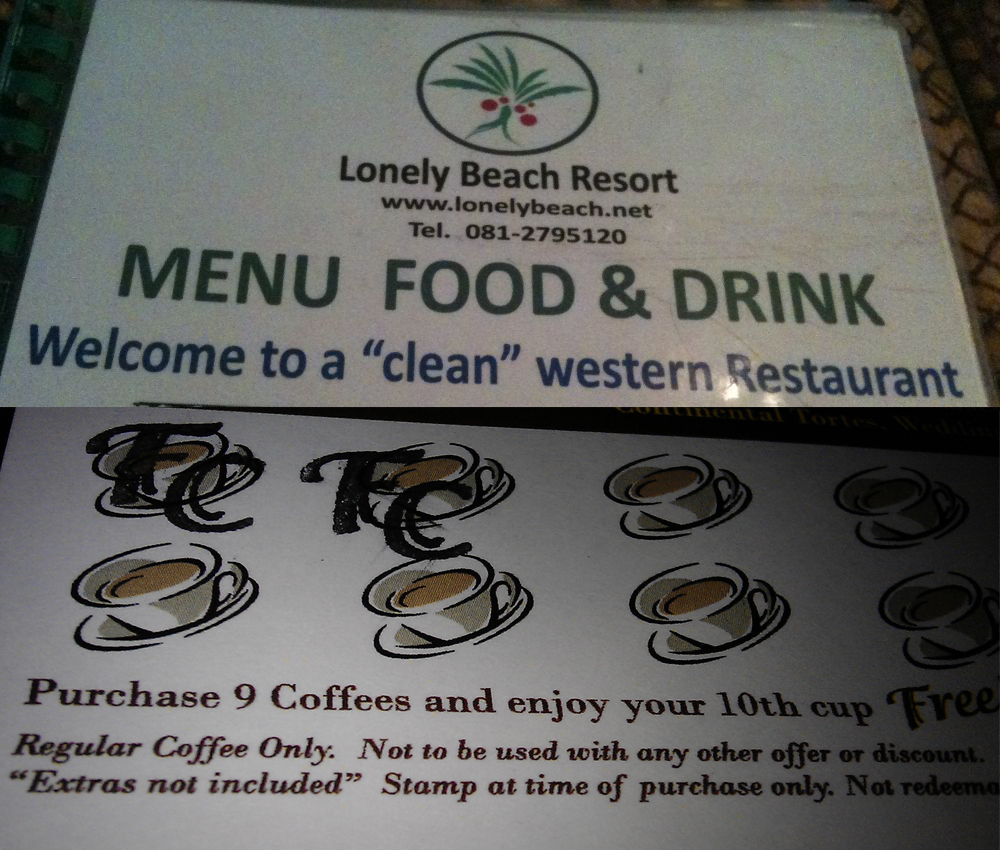
Speaking of air quotes for sarcasm, here’s another clip from Friends.
In this one, Joey doesn’t know what the air quotes mean and uses them incorrectly as a result.
Sure, we have time for more examples:

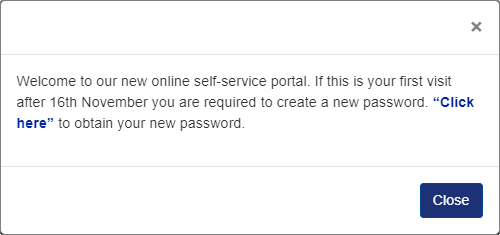

To conclude, quotation marks are “not” used for emphasis. Damn it!
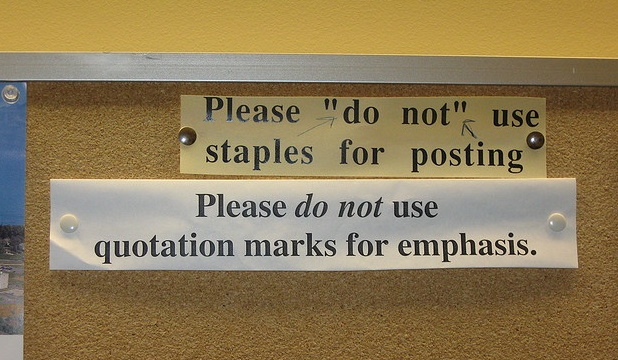
Single or double quotation marks?
But do I use single or double quotation marks? Excellent question! Thanks for asking! Although we have somewhat walked into a debate.
Okay so I tend to use double quotation marks for when I’m directly quoting someone (check out the start of this topic when I gave the Shakespeare quote) and then single quotation marks for everything else, for example, when I’m referring to a word or some text I’ve mentioned earlier, and I’m making it clear that this is the topic being referred to. Take a look at I could care less: phrases gone wrong and how I’ve used single quotation marks there. Without the quotation marks, my sentences would be a little confusing. Take a look at the following joke.
I changed my password to ‘incorrect’ so whenever I forget what it is, the computer will tell me ‘Your password is incorrect’.
I changed my password to incorrect so whenever I forget what it is, the computer will tell me Your password is incorrect.
Reads a bit funny doesn’t it? The quotation marks just give a bit more clarity don’t they?
Anyway, I digress. So that’s how I generally use single and double quotation marks, however, it seems that Australian English generally prefers single quotation marks overall and American English prefers the double. The only time in Australian English where you would use double is if you’re quoting someone inside of a quotation:
At school today, my English teacher said ‘Class, you have five minutes to write down your favourite Shakespeare quote, for example “Better a witty fool than a foolish wit” and why.’
Again, it’s debatable whether you use the single or double method, but my best advice is to:
- be consistent – don’t use single sometimes and then switch to double because you will confuse your readers
- consult your style guide. Obviously this depends on what you’re writing and your audience.
Speaking of singular quotation marks, specifically opening ones, don’t confuse these with apostrophes, otherwise you’ll end up doing what the logo maker did for the pizza logo, which I referenced in Apostrophe Misuse 101 – at the end of the section on Contractions.
The difference between colons and semicolons
This is a tricky one, especially since they both look very similar! Firstly let’s look at what they look like and then we’ll analyse both.
Actually, you know what? We touched a little on colon and semicolon usage in Essential comma usage – Where are commas not used? So have a read of that section first if you haven’t already, just to get your toe in, and then meet me back here.
Welcome back. Okay so a colon is the character that looks like two full stops on top of each other. You’ll find it to the right of the letter L on the keyboard but you’ll need a shift to enter it.
A semicolon is what happens when you type the above key without Shift first and it looks like a full stop on top of a comma.

Colons
Colons are generally used for when you’re saying one thought and then providing more information about it. Let’s look at some examples:
- The data was clear: 74% of students passed the test
- My friend and I stared in horror: the clown had come to life
- The kids were so excited: they had just found out they were going to Disneyland!
- Simba had asked an interesting question: what was the dark, shadowy place?
Used in a similar way to the above, colons can also be used when introducing a list:
- You have two options: put up with it, or quit
- I have three favourite bands: The Beatles, Coldplay, and Oasis.
In a sense, you’re omitting words with this usage:
- You have two options (what are they?) Put up with it, or quit.
- I have three favourite bands. (Which ones?)…
- The kids were so excited. Why? They were going to Disneyland
- We stared in horror. But why? Here’s why…
You get the gist…
Colons are also used where you’re introducing a bulleted or numbered list:
For this recipe you will need:
- One eye of newt
- Two vials of adder venom
- One lizard leg
- Three strands of shrew fur
- 300 ml white vinegar
Gosh, I’m not sure where that recipe was copy and pasted from. Also take a look at the Contents above. I’m introducing a list so I use a colon. Anyway, more on bulleted lists in the next section.
Now, let’s touch a little bit on incorrect usage.
- The countries we’re visiting in Europe are: France, Italy, and Spain
- We stared in horror because: the evil clown came to life
- My favourite subjects I studied at university were: Professional Writing, Script Writing, and Film Studies.
With these three, the colon is incorrect because there’s no omission happening. If you remove the colon, the sentence still makes sense. It’s kinda like what I said above about quotation marks isn’t it?
So, to recap, you make a statement, use a colon, and then the next statement clarifies or adds more information to the original statement.
What on earth is ‘Remember voting’? It’s clear that whoever wrote this for the Labor Party needs to tune in to this blog post.
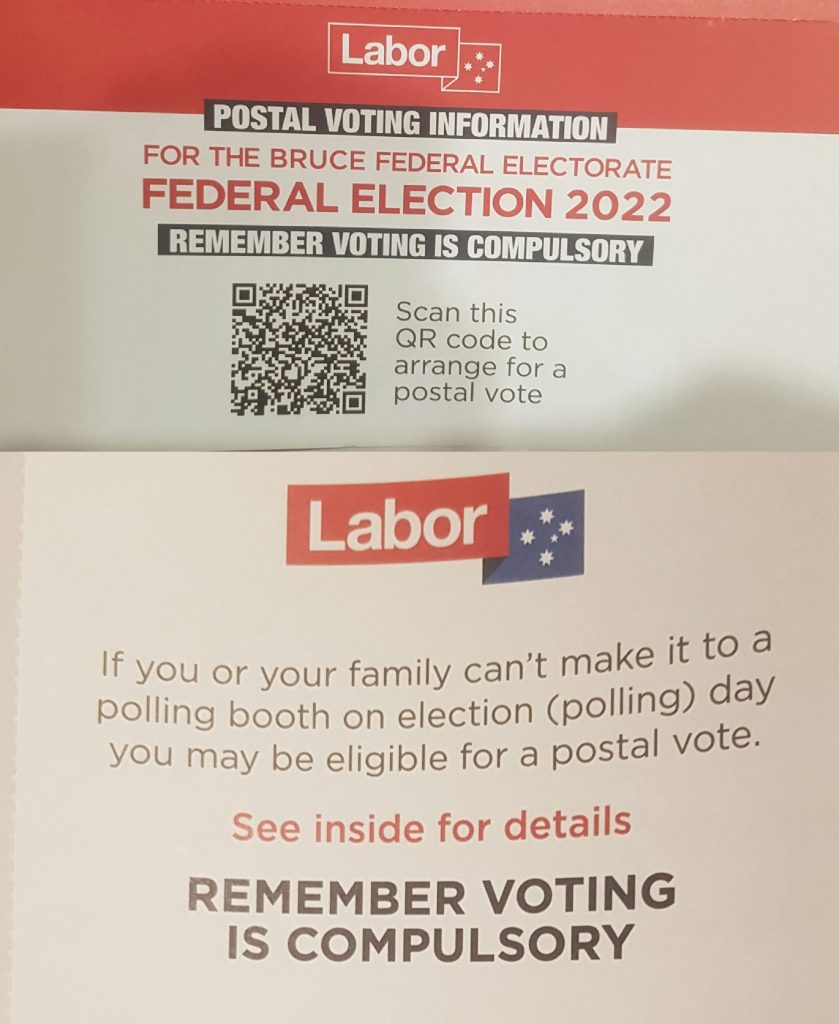
Now, there is another type of colon and it’s to do with your bowels. You probably wouldn’t use this too much in your writing though. But I will say not to confuse the word ‘Colon’ with the word ‘Cologne’ though.
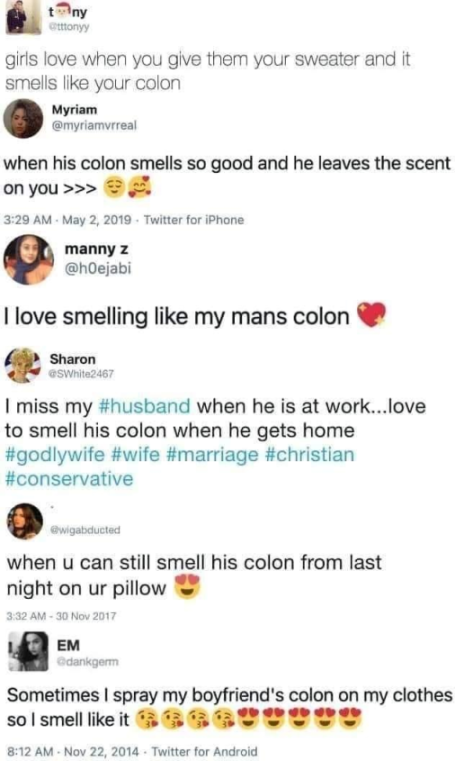
Semicolons
Oooh… Interesting territory. Using semicolons correctly in your writing will make you look smart! Using them incorrectly on the other hand… Well…
Okay so guess what? Semicolons are actually used in a similar fashion to colons, but there’s one exception: the second clause (statement) doesn’t necessarily give more information about/complete the first. Let’s look at some examples:
- She walked past me in class today; she was wearing sweet-smelling perfume
- I ordered a burger with the lot and a large chips; carbs don’t count on the weekend
- When we’re together, we create great music; it’s all about the music.
Can you see how you could easily use a full stop and start a new sentence, but you’re linking the sentences in some way by using a semicolon.
You could also use a conjunction like ‘and’ or ‘but’, but using a semicolon just sounds better:
Without semicolon:
- We saw a werewolf in the haunted forest and it was eating a meaty carcass
- James raised a good point in the meeting and it was something no one had pointed out.
With semicolon:
- We saw a werewolf in the haunted forest; it was eating a meaty carcass
- James raised a good point in the meeting; something no one had pointed out.
Remember that if you used commas instead of semicolons in these examples, you’d be creating something called a comma splice!! 😲 Once again, check out Essential comma usage – Where are commas not used? as I spoke about this here.
Never be afraid to use a semicolon; it makes you look smart.
– Raff Lagatta
Complex Lists
As well as connecting clauses, semicolons are also used when you’re writing a list, but commas just aren’t quite powerful enough. Take a look at Where are commas used? – When listing items, for using commas in basic lists.
Let’s take an example of a basic list:
On our holidays, we travelled to France, Italy, Spain, and England.
Seems easy enough. But what if we wanted to up the stakes and say the specific places we visited within these countries?
On our holidays, we travelled to Paris, France, Venice, Italy, Barcelona, Spain, and London, England.
Congratulations: you’ve now thoroughly confused the whole world. Okay so here’s where semicolons come in. Since the commas are separating the places from their respective countries, rather than using commas again to separate the items in the list, use semicolons:
On our holidays, we travelled to Paris, France; Venice, Italy; Barcelona, Spain; and London, England.
Ah… Magnifique! 👍🏼
Let’s look at one more example:
Three main characters in the series are Ned Stark, a dedicated husband and father; Tyrion Lannister, a witty and intelligent dwarf; and Jon Snow, a loyal warrior.
Again, the semicolons are separating the items in the list, and commas are separating the extra info about each item we’re putting forward.
Colons vs Semicolons
Can you see now that a colon either completes the first statement or gives more information about it, whereas a semicolon links the two statements without explaining or giving more clarity to the first. Let’s have a look at a couple more sentences, just to drive the point home:
Scenario 1:
- James raised a good point at the start of the meeting: who was meant to be running it?
- James raised a good point in the meeting; something no one had pointed out.
Explanations:
- James raised a good point. What was the point he raised? It was this…
- James raised a good point and it was something no one had noticed. Using a colon here would not work as ‘something no one had pointed out’ doesn’t directly relate to James’ good point, therefore a semicolon is the right choice!
Scenario 2:
- She sat next to me in class today: there were no other seats left.
- She walked past me in class today; she was wearing sweet-smelling perfume.
Explanations:
- The reason why she sat next to me was because there were no other free seats (I feel bad for the author).
- The fact that she was wearing perfume doesn’t explain why she walked past me.
Just make sure not to confuse a semicolon with a colon when writing a list, whether this be a written sentence:
I have three favourite bands; The Beatles, Coldplay, and Oasis.
or a bulleted list:
The successful applicant must have;
- 20 years of experience
- coffee making experience
- the ability to use semicolons correctly
Bullet points and their correct usage
Okay so just a short and sharp one to finish off this session and it fits nicely here since we’ve discussed bulleted lists a fair bit.
Take a look at this image. Okay so we’ve used a colon to introduce both lists which is a fantastic start. However, take a look at the first list. What we’re saying for the heading needs to match up with the list content and only two of them do that:
- We are looking for experience resolving customer enquiries (they’ve unfortunately spelt it wrong. Check out the footnote on Enquiry and Inquiry).
- We are looking for demonstrated ability…..
The other two in that first list miss the mark:
- We are looking for must have previous experience.
- We are looking for demonstrate effective problem-solving ability.
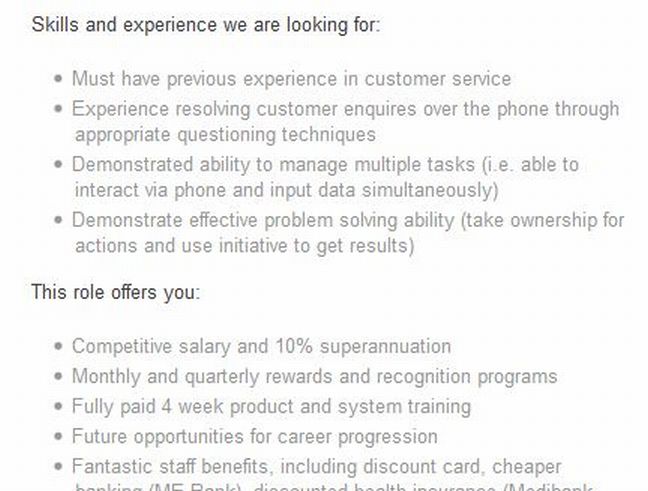
Note that with first one, although it makes sense grammatically, it’s also sort of missed the mark because it says they are looking for experience resolving customer enquiries, when really, they are wanting the applicant to have these abilities…
Job advertisements do this a lot! If it’s not the introducing of the list with a semicolon instead of a colon, it’s this one where the content doesn’t match up with the heading.
Anyway, how to resolve this? My best advice would be to reword the heading so that it fits with all of the bullet points. Something like:
The successful applicant ideally should have:
- Previous experience in…
- Experience resolving customer enquiries
- Demonstrated ability…
- Effective problem-solving ability
Sorted! Now all of your bullet points align with the heading!
And there may be a bunch of ways to do this depending on the content! For example, you could have a heading of:
The successful applicant should be able to demonstrate:
and then list all the things you want the applicant to be able to demonstrate.
Overall, when constructing lists such as these, just remember to take a step back before you press the Send to all button:
- Write what you wanna say about each point.
- Edit them as necessary as you go along.
- Once finished, read each one together with the heading to make sure they all make sense. If one doesn’t, it’s time to reword either by changing the dot point or by changing the heading and possibly changing a bunch of your dot points.
Another example of bad usage where some of the bullet points (which literally seem to be missing, by the way) don’t quite line up with the heading.
We’re also missing the colon after the heading.
We also have misspelled esteem (steam), and, considering this image was taken in Australia, defence (defense).
Recap: Easy ways you can spot Americanizms – -se and -ce endings.
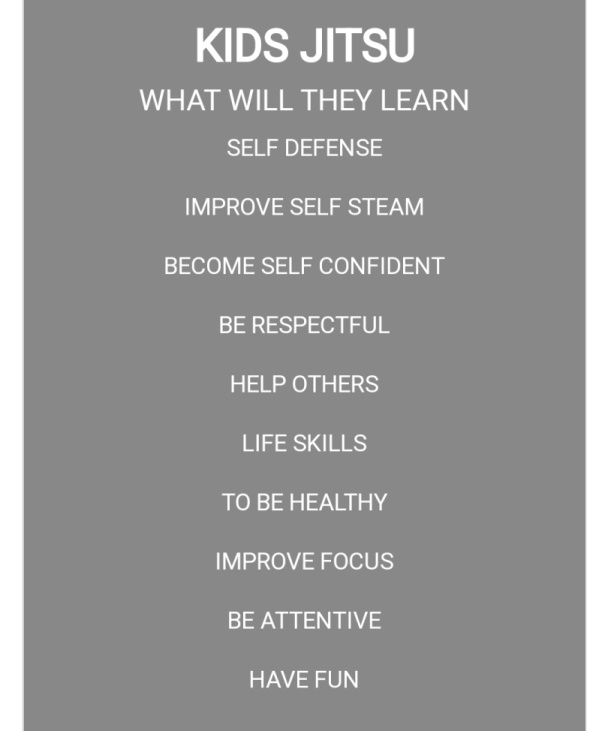
While we’re on the topic of marketing, remember not to confuse Asterisk with Asterix!
And that’s all for today! We’ve looked at quotation marks and when and when not to use them, the difference between colons and semicolons, and the basis around using bulleted lists. Share this with your fellow marketing peers if you feel they need a bit of a recap with any of these topics. We’ll touch base with you next time!

